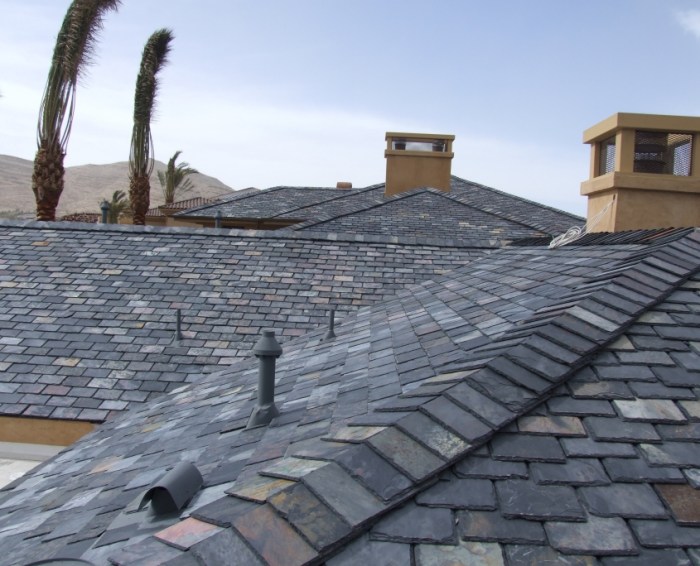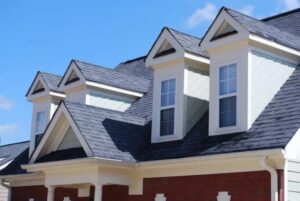
Fire-resistant roofing materials are essential in enhancing the safety and security of homes. As wildfires and extreme weather events become more prevalent, homeowners are increasingly looking for ways to protect their properties. This guide dives into the various types of fire-resistant roofing options available, their benefits, and installation processes, making it easier for you to make informed choices.
From metal roofs to clay tiles and synthetic materials, the options are diverse and engineered to withstand flames and heat, offering peace of mind for homeowners. Not only do these materials provide a crucial barrier against fire, but they can also positively influence home insurance premiums and serve as a deterrent against fire-related damage.
Types of Fire-resistant Roofing Materials

Fire-resistant roofing materials play a crucial role in enhancing the safety and longevity of a structure. These materials are specially designed to withstand high temperatures and prevent the spread of flames, making them essential in areas prone to wildfires or in buildings that require higher safety standards. Understanding the various types of fire-resistant roofing options available can help homeowners and builders make informed decisions that align with safety regulations and aesthetic preferences.The market offers a diverse range of fire-resistant roofing materials, each with unique properties and benefits.
These materials not only provide protection against fire but can also contribute to energy efficiency and aesthetic appeal. Below, we explore some of the most common types of fire-resistant roofing materials, detailing their characteristics, advantages, and installation processes.
Asphalt Shingles
Asphalt shingles are one of the most widely used roofing materials across North America, known for their affordability and ease of installation. Fire-resistant asphalt shingles are treated with fire retardants and are rated according to the ASTM E108 standard.
- Properties: These shingles can withstand flames for a prolonged period, helping to slow down fire spread. They come in various styles and colors, allowing for aesthetic customization.
- Benefits: Their lightweight nature simplifies installation and repairs, while their affordability makes them a popular choice for budget-conscious homeowners.
- Installation Process: Typically, asphalt shingles are applied over a solid deck and require underlayment for added fire resistance. Proper overlap and nailing techniques are crucial for ensuring durability against weather elements.
Metal Roofing
Metal roofing has gained popularity for its durability and longevity. Materials such as steel, aluminum, and copper are commonly used, and many manufacturers offer products with high fire ratings.
- Properties: Metal roofs are non-combustible and can reflect heat, enhancing energy efficiency. They are resistant to rust and corrosion, ensuring a long lifespan.
- Benefits: These roofs can last 40-70 years, significantly reducing replacement costs. They are also lightweight, which can reduce structural load.
- Installation Process: Metal roofing panels are typically installed over a solid substrate, with the seams interlocking to enhance waterproofing and fire resistance. Proper insulation and ventilation are imperative to prevent condensation under the roofing.
Concrete and Clay Tiles
Concrete and clay tiles are known for their impressive durability and classic aesthetic. These materials are naturally fire-resistant due to their composition.
- Properties: Both concrete and clay tiles can withstand extreme temperatures and are not prone to rotting, insect damage, or fire.
- Benefits: They provide excellent insulation, helping to maintain indoor temperatures. Their distinctive style can enhance the curb appeal of a home.
- Installation Process: Installing tile roofs often requires a more complex framework to support the weight of the tiles. Tiles are laid in overlapping patterns, requiring precise alignment to ensure proper drainage and fire resistance.
Modified Bitumen
Modified bitumen is a type of flat roofing system that incorporates asphalt with modifiers, enhancing its performance.
- Properties: It is highly resistant to fire, UV radiation, and extreme weather conditions. Modified bitumen is also flexible, allowing it to expand and contract with temperature changes.
- Benefits: This material is ideal for commercial buildings and provides a robust barrier against moisture and fire.
- Installation Process: Modified bitumen is typically installed using heat or cold adhesive methods, requiring careful layering to ensure a watertight seal and optimal fire resistance.
“Selecting the right fire-resistant roofing material is essential for improving safety and enhancing the overall value of your property.”
Benefits of Fire-resistant Roofing in Home Security

Fire-resistant roofing materials play a crucial role in enhancing the overall security of a home. By providing a protective barrier against flames and extreme heat, these materials significantly reduce the risk of fire damage. In addition to safeguarding the structure, fire-resistant roofs can also have positive implications for your homeowner’s insurance and offer vital protection during wildfire seasons or severe weather events.
Impact on Home Insurance Premiums
Installing fire-resistant roofing can lead to lower home insurance premiums. Insurance providers typically reward homeowners who take preventive measures to protect their property from fire hazards. This not only reflects a reduced risk for the insurer but also translates to tangible financial benefits for the homeowner. Many insurers may offer discounts ranging from 5% to 30% on premiums for homes equipped with fire-resistant roofing solutions.
Protection Against Wildfires and Extreme Weather Events
Fire-resistant roofing materials are particularly beneficial for homes located in areas prone to wildfires. The added layer of protection significantly lessens the likelihood of a home catching fire from embers or direct flames. Additionally, these roofs can withstand high winds and heavy rains, contributing to a home’s resilience during storms. The following points highlight the advantages of fire-resistant roofing in safeguarding homes:
- Higher Resistance to Flames: Fire-resistant materials are designed to resist ignition and slow down fire spread, providing critical time for evacuation and emergency response.
- Reduction of Ember Attack Risk: In wildfire situations, embers can travel long distances and ignite flammable materials. Fire-resistant roofs help mitigate this risk.
- Improved Durability: These roofs are often made from materials such as metal, slate, or concrete, which not only resist fire but also offer longevity against extreme weather conditions.
- Insurance Incentives: As mentioned, having fire-resistant roofing can lead to discounts on home insurance, ultimately saving homeowners money.
- Increased Home Value: Homes with fire-resistant roofing are more appealing to potential buyers, especially in fire-prone regions, thus enhancing property value.
Investing in fire-resistant roofing not only protects your home but also contributes to peace of mind and financial savings.
Comparisons of Fire-resistant Roofing Materials
When considering fire-resistant roofing materials, it’s essential to evaluate their performance across various parameters. The choice of a roofing material not only affects the safety and resilience of a home but also impacts its overall maintenance and long-term costs. Here’s a comparative analysis of several popular fire-resistant roofing options.
Cost, Durability, and Maintenance
Understanding the cost, durability, and maintenance requirements of different fire-resistant roofing materials allows homeowners to make informed decisions. Below is a detailed comparison of four common types of fire-resistant roofing materials: metal, asphalt shingles, tile, and synthetic materials.
| Material | Cost (per sq ft) | Durability | Maintenance |
|---|---|---|---|
| Metal | $3 – $6 | Highly durable (40-70 years) | Low; occasional painting and cleaning |
| Asphalt Shingles | $1 – $5 | Moderately durable (15-30 years) | Moderate; yearly inspections recommended |
| Tile | $5 – $15 | Very durable (50+ years) | Low; periodic inspections |
| Synthetic | $3 – $10 | Durable (30-50 years) | Low; minimal upkeep required |
The table illustrates the various aspects of each roofing type. Metal roofs, while initially pricier, offer exceptional durability and require minimal maintenance, making them a cost-effective choice over time. Asphalt shingles are the most economical upfront but require more frequent replacement and maintenance. Tile roofs are renowned for their longevity and aesthetic appeal, albeit at a higher cost, while synthetic materials strike a balance between cost and durability with low maintenance requirements.
Environmental Impact and Sustainability
The environmental consequences of roofing materials are increasingly relevant in today’s eco-conscious society. Assessing sustainability involves evaluating the resources used in production, energy efficiency, and end-of-life disposal.Metal roofing is highly sustainable as it is often made from recycled materials and is fully recyclable at the end of its life. It also reflects solar energy, reducing cooling costs, which helps lower overall energy consumption.Asphalt shingles, on the other hand, have a higher environmental impact due to their petroleum-based production.
While they can be recycled, the availability of recycling facilities varies widely.Tile roofs, made from natural clay or concrete, are sustainable; however, their production is energy-intensive. They boast an extended lifespan, which can offset their initial environmental costs.Synthetic roofing materials are typically made from a blend of recycled and virgin materials. While they are often lighter and easier to install, the long-term sustainability can vary based on the specific product and its lifecycle management.In summary, when selecting fire-resistant roofing materials, homeowners should not only consider cost and durability but also the environmental implications of their choices.
Each material has its unique strengths and weaknesses, making it crucial to align the choice with personal values and practical needs.
Ultimate Conclusion
In summary, investing in fire-resistant roofing materials is a proactive approach to safeguarding your home from potential fire hazards. By understanding the types available and their respective advantages, you can make educated decisions that enhance your home’s resilience. Ultimately, the right roofing choice not only protects your property but also contributes to overall community safety.
General Inquiries
What are the most common fire-resistant roofing materials?
The most common fire-resistant roofing materials include metal, slate, concrete tiles, and clay tiles.
How do fire-resistant roofs affect home insurance premiums?
Fire-resistant roofs can lower home insurance premiums as they reduce the risk of fire damage.
Can fire-resistant roofing materials be installed on existing roofs?
Yes, many fire-resistant materials can be retrofitted onto existing roofs, though it’s essential to consult with a professional.
How do I maintain fire-resistant roofing?
Regular inspections, cleaning debris, and ensuring proper drainage are key to maintaining fire-resistant roofing.
Are fire-resistant roofing materials environmentally friendly?
Many fire-resistant roofing materials are sustainable, with options like metal and clay being recyclable and offering long-lasting durability.







